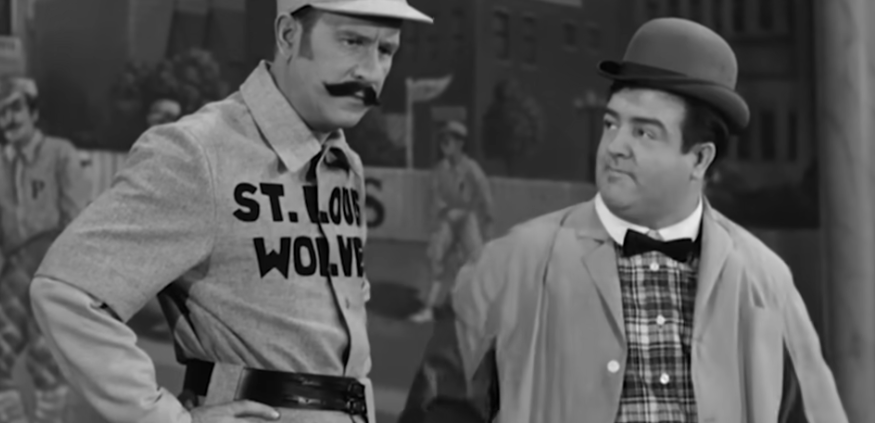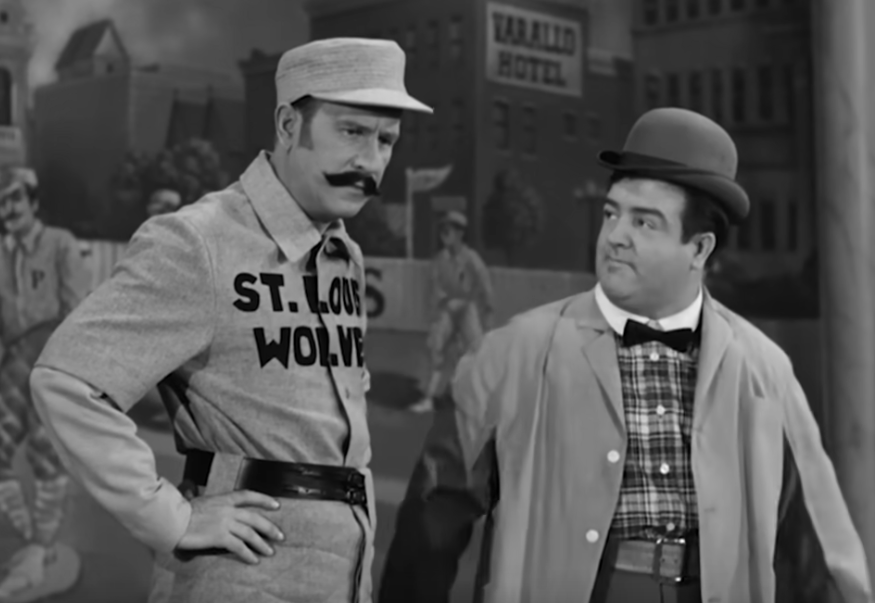Legendary Comedy Duo Abbott and Costello Swings Open 1948 Atlanta Crackers Season
This article was written by Brian Williams
This article was published in When Minor League Baseball Almost Went Bust: 1946-1963
Comics Bud Abbott and Lou Costello perform “Who’s On First” in the film “The Naughty Nineties”. (Library of Congress)
Bud Abbott: Well Costello, I’m going to New York with you. You know Bucky Harris, the Yankees’ manager, gave me a job as coach for as long as you’re on the team.
Lou Costello: Look, Abbott, if you’re the coach, you must know all the players.
Abbott: I certainly do.
Costello: Well you know I’ve never met the guys. So you’ll have to tell me their names, and then I’ll know who’s playing on the team.
Abbott: Oh, I’ll tell you their names, but you know it seems to me they give these ballplayers nowadays very peculiar names.
Costello: You mean funny names?
Abbott: Strange names, pet names … like Dizzy Dean…
Costello: His brother Daffy.
Abbott: Daffy Dean …
Costello: And their French cousin.
Abbott: French?
Costello: Goofe.
Abbott: Goofe Dean. Well, let’s see, we have on the bags, Who’s on first, What’s on second, I Don’t Know is on third…1
While Bud and Lou touched their audience’s funnybones through a variety of vaudeville, radio, film, and, later, television acts, this baseball-themed gem seemed to gravitate to the top of the pair’s repertoire. Most baseball fans and comedy sketch aficionados can still recite much of Abbott and Costello’s classic skit. Fewer may know about the skit’s appearances on the baseball field and in American popular culture.
On Friday, April 16, 1948, Bud and Lou’s live performance of “Who’s on First?” graced a professional baseball team’s Opening Day at the ballfield at the corner of Atlanta’s Ponce de Leon Avenue and Lakeview, known at the time as Ponce de Leon Park.
This was one of several appearances by the comedy duo in the Atlanta area that weekend. Bud and Lou visited a federal penitentiary and two hospitals the day before the game. One hospital patient, Patrolman R.C. West, was a specific target of their humor. They wanted to lift the spirits of the police officer, whose leg had been amputated after a recent gun battle. Abbott and Costello joked with the heroic officer and the nursing staff. That evening, they entertained overflow audiences with two live shows at the Paramount Theater, coinciding with the opening of their new comedy film, The Noose Hangs High.
The next day the comedy team stepped onto the same field as two teams in the Southern Association. With twilight spring temperatures hovering in the mid-60s, the Birmingham Barons and Atlanta Crackers prepared to begin a new season before 21,812 eager fans.2 Suddenly, Bud Abbott and Lou Costello stepped to the microphone stand at home plate.
Atlanta’s Ponce de Leon Park erupted with laughter throughout the skit featuring its original comedy team. The huge crowd hung on every line.
Bud Abbott: You throw the ball to Who?
Lou Costello: Naturally.
Bud Abbott: That’s it.
Lou Costello: Same as you! Same as YOU! I throw the ball to Who. Whoever it is drops the ball and the guy runs to second. Who picks up the ball and throws it to What. What throws it to I Don’t Know. I Don’t Know throws it back to Tomorrow, triple play. Another guy gets up and hits a long fly ball to Because. Why? I don’t know! He’s on third and I don’t give a darn!
Bud Abbott: What?
Lou Costello: I said I don’t give a darn!
Bud Abbott: Oh, that’s our shortstop.1
Abbott and Costello regaled the standing-room Opening Day crowd for a full 15 minutes before taking their bows and yielding to the Crackers’ starting defenders. The fans roared their approval and eagerness to begin a new season. After all, the Crackers played before an average crowd of 5,309 in 19473 while this Opening Day attendance eclipsed 21,800. The previous record crowd (21,500) at the park watched a 1946 spring game that the Crackers hosted against the Yankees.
One of those in attendance was Pearl Sandow, who missed only one Crackers home game between 1934 and 1966. She switched allegiance when the Braves brought their National League team to Atlanta. Pearl attended more than 1,850 Crackers games at Ponce de Leon Park before she advanced to the majors and, ultimately, the fans section of the Baseball Hall of Fame. On this day Pearl followed her usual routine of leaving her federal Housing Department career and heading directly to the ballpark.4
Once baseball took center stage, the two Southern Association teams sought to entertain the masses following so-so performances the previous season. In 1947 the Crackers rode an average of just under five runs per game to a 73-78 record, 20 games off the pace set by the Mobile Bears. The Barons (73-80) stayed on the heels of Atlanta in the standings, as well as in team batting and pitching. Only Memphis and Little Rock fared worse. The top two teams, Mobile and the New Orleans Pelicans, won more than 90 games.
Kiki Cuyler’s Crackers opened this season’s scoring on a first-inning infield single by Neb Wilson. Atlanta threatened to score more; however, Birmingham starting left-hander Irv Medlinger wriggled out of the inning with a pop fly and a strikeout.
The Barons took the lead in the third as former Cracker Tommy O’Brien smoked a two-run double down the left-field line. In the sixth, O’Brien, a wartime major leaguer with Pittsburgh, recorded his second hit of the game and scored on a fly ball by player/manager Fred Walters.
The Crackers came storming back in the bottom half keyed by catcher Red Mathis, who doubled in a pair. The go-ahead run scored on a passed ball to give Atlanta a 4-3 lead.
The Barons reknotted the score at 4-4 in the top of the seventh. Then Carl Lindquist relieved for the Crackers and stifled the Birmingham rally. Lindquist had pitched 21 1/3 innings for the Boston Braves during World War II.
The Crackers broke the tie by tallying three two-out runs in their seventh-inning turn. Two walks, two singles, and Mathis’s second double of the day did the damage. Atlanta added three more runs in the eighth off reliever Mike Gast. The Barons scratched out a run in the final frame without a hit, thanks to catcher’s interference, a throwing error, and a fly out.
Southpaw Bill Kennedy earned the win. He finished the season at 15-15, and recorded one win in three years of major-league roster time. Birmingham’s George Washington Wilson led all hitters with three safeties in this season opener. He wrapped up his 1948 season hitting .335 with 27 home runs. In 1952 Wilson debuted in the majors with the New York Giants and eventually logged time with the Yankees as well. In addition to Wilson’s three, the Barons logged 11 more hits in the game, yet could only dent the plate five times. The 11-5 defeat to the Crackers did not deter the Birmingham squad, which went on to win the 1948 Southern Association championship with a record of 84-69. In the playoffs, the Barons disposed of Memphis and Nashville in two 4-2 series wins, even though both teams had finished with better regular-season records.
The Crackers, meanwhile, fell to sixth place and completed another mediocre season (69-85). The most memorable point of that season for the Crackers’ faithful may have been that first victory and the legendary Abbott and Costello’s pregame performance of “Who’s on First?”
“Who’s on First?” has had a remarkably long run. The skit originated almost a decade before Abbott and Costello’s live performance at the Crackers’ opener. It debuted in 1937 on a vaudeville revue tour. Then, a year later, in March 1938, after joining the cast of The Kate Smith Hour radio program, Abbott and Costello treated radio listeners to “Who’s on First?” Their first film, One Night in the Tropics, included the skit, which was becoming so popular that the comedy duo copyrighted the routine in 1944. They also included it in their 1945 film The Naughty Nineties, which some consider their finest recorded performance.
“Who’s on First?” reached Cooperstown in 1953, eight years after Abbott and Costello’s Atlanta performance, when a golden record of the skit was added to the permanent display on the second floor of the National Baseball Hall of Fame and Museum. At the time of the announcement, Costello said, “This is many times better than getting an Oscar.” A video of the stellar The Naughty Nineties version still plays on screens inside the Hall.
During the 1956 World Series The Steve Allen Show, a variety hour on NBC-TV, featured a salute to baseball. Guests on the show included Mickey Mantle and Claire Ruth, Babe Ruth’s widow. Steve Allen then introduced “two men who have made a very unique contribution to the game in a lighter vein.” The 58-year-old Abbott and 50-year-old Costello came on stage in their baseball uniforms along with two executives from the Hall of Fame to talk about the new display in Cooperstown. After the applause died down, Allen introduced what some claim to be the final performance of “Who’s on First?” Fittingly, the very next day, Don Larsen pitched his World Series perfect game. Within a year the Abbott and Costello comedy team broke up.
Despite the duo’s split, the reach of the skit continued to grow. A “Who’s on First?” board game was marketed in the 1970s. Time magazine named the routine “Best Comedy Sketch of the 20th Century” in a 1999 issue. The Library of Congress placed an early radio recording of the piece in its National Recording Registry in 2003. Two years later—66 years after its initial performance—the line “Who’s on First?” was included on the American Film Institute’s list of 100 memorable movie quotes.
“Who’s on First?” succeeded in breaking generational barriers and lives on to entertain millions of baseball and comedy fans. On an MLB Network “Who’s on First?” special in 2012, Jerry Seinfeld helped explain why: “Any great comedy is how far can you take this silly idea. I mean the initial idea is just a first baseman named ‘Who.’ And then you get the ‘What,’ then the ‘I Don’t Know,’ and it keeps going. You think it’s out of gas, and it’s not. That’s what makes this great.”5
From Max Patkin, the Clown Prince of Baseball, to today’s team mascots; from dogs serving as batboys to a famous comedy team performing its most famous skit to promote a new movie and entertain a pregame crowd on Opening Day in Atlanta in 1948, baseball and fun have always been on the same team.
THE “WHO’S ON FIRST?” TEAM LINEUP
- First Base: Who
- Second Base: What
- Third Base: I Don’t Know
- Left field: Why
- Center field: Because
- Pitcher: Tomorrow
- Catcher: Today
- Shortstop: I Don’t Give a Darn
- The right fielder is never named.
BRIAN WILLIAMS began writing as a high-school sports stringer before launching a broadcast, writing, and voice-over career at age 15. He has performed radio play-by-play for PIAA state championship baseball and football as well as some minor-league baseball. After he built a new FM radio station with three partners, added an AM station, and sold both in 2001, Brian switched gears to a career in medical equipment software, where he authored several articles for national trade magazines. Brian still writes and voices projects (brianwilliamscreative.com), and currently works with a middle-school emotional support team and coaches high-school baseball in Harrisburg, Pennsylvania.
ACKNOWLEDGMENTS
This article was edited by Cathy Kreyche and fact-checked by Kevin Larkin.
SOURCES
Williams, F. M. “Crackers Lick Barons in Debut Before 21,812,” Atlanta Constitution, April 17, 1948.
Bennett, Byron. “Atlanta’s Other Lost Ballpark—Ponce De Leon Park.” Deadball Baseball, August 5, 2013. https://deadballbaseball.com/2013/08/atlantas-other-lost-ballpark-ponce-de-leon-park/.
Walker, Buss. “Mawnin’!,” Chattanooga Daily Times, April 19, 1948.
Fenster, Kenneth R., Georgia State University Perimeter College. “Pearl
Sandow, 1902-2006.” https://www.georgiaencyclopedia.org/articles/sports-outdoor-recreation/pearl-sandow-1902-2006/.
Francis, Bill. “Who’s on First Joined the Hall 60 Years Ago.” National Baseball Hall of Fame. February 6, 2016. https://baseballhall.org/discover/short-stops/whos-on-first.
“1947 Southern Association.” Baseball Reference. BR Bullpen. https://www.base-ball-reference.com/register/league.cgi?id=92db4b25 (statistics on the 1947 season).
“Ponce de Leon Park.” New Georgia Encyclopedia (n.p.: Georgia Humanities, University of Georgia Press, n.d.). https://www.georgiaencyclopedia.org/articles/sports-outdoor-recreation/ponce-de-leon-ballpark/.
“Who’s on First?” Baseball Reference. BR Bullpen. https://www.baseball-refer-ence.com/bullpen/Who%27s_on_First%3F (“Who’s on First?” history).
NOTES
1 “Who’s on First?” script. https://abbott-and-costello-whos-on-first.info/whos-on-first-script/.
2 Atlanta Crackers 1948 Attendance figures and roster. https://www.statscrew.com/minorbaseball/roster/t-ac10221/y-1948.
3 Atlanta Crackers 1947 Attendance figures. https://www.statscrew.com/minorbaseball/roster/t-ac10221/y-1947.
4 Kenneth R. Fenster, Georgia State University Perimeter College, “Pearl Sandow, 1902-2006.” https://www.georgiaencyclopedia.org/articles/sports-outdoor-recreation/pearl-sandow-1902-2006/.
5 Bill Francis, “Who’s on First Joined the Hall 60 Years Ago,” National Baseball Hall of Fame. February 6, 2016. https://baseballhall.org/discover/short-stops/whos-on-first.



